Polytechnic Institute Australia ACC203 Management Accounting Report
VerifiedAdded on 2023/06/04
|10
|2105
|107
Report
AI Summary
This report provides a comprehensive analysis of management accounting practices, focusing on the shift from compliance and control to competitive support in modern business environments. The first part of the report discusses the factors contributing to the development of management accounting, including cost leadership, differentiation, and strategic risk management, and evaluates the usefulness of the Balanced Scorecard as a key tool. The second part of the report delves into a case study of Qantas, an ASX-listed company. It identifies Qantas's critical success factors (CSFs) and key performance indicators (KPIs), constructs a strategic map aligning with Qantas's long-term objectives, and develops a Balanced Scorecard based on the analysis of the company's annual report. The report integrates theoretical concepts with practical application, providing a detailed examination of management accounting principles and their application in a real-world business context, with the goal of aiding strategic decision-making and performance evaluation. This report is designed to provide a comprehensive understanding of the role of management accounting in today's business environment, and the key tools and strategies that are used to drive performance and achieve strategic objectives.
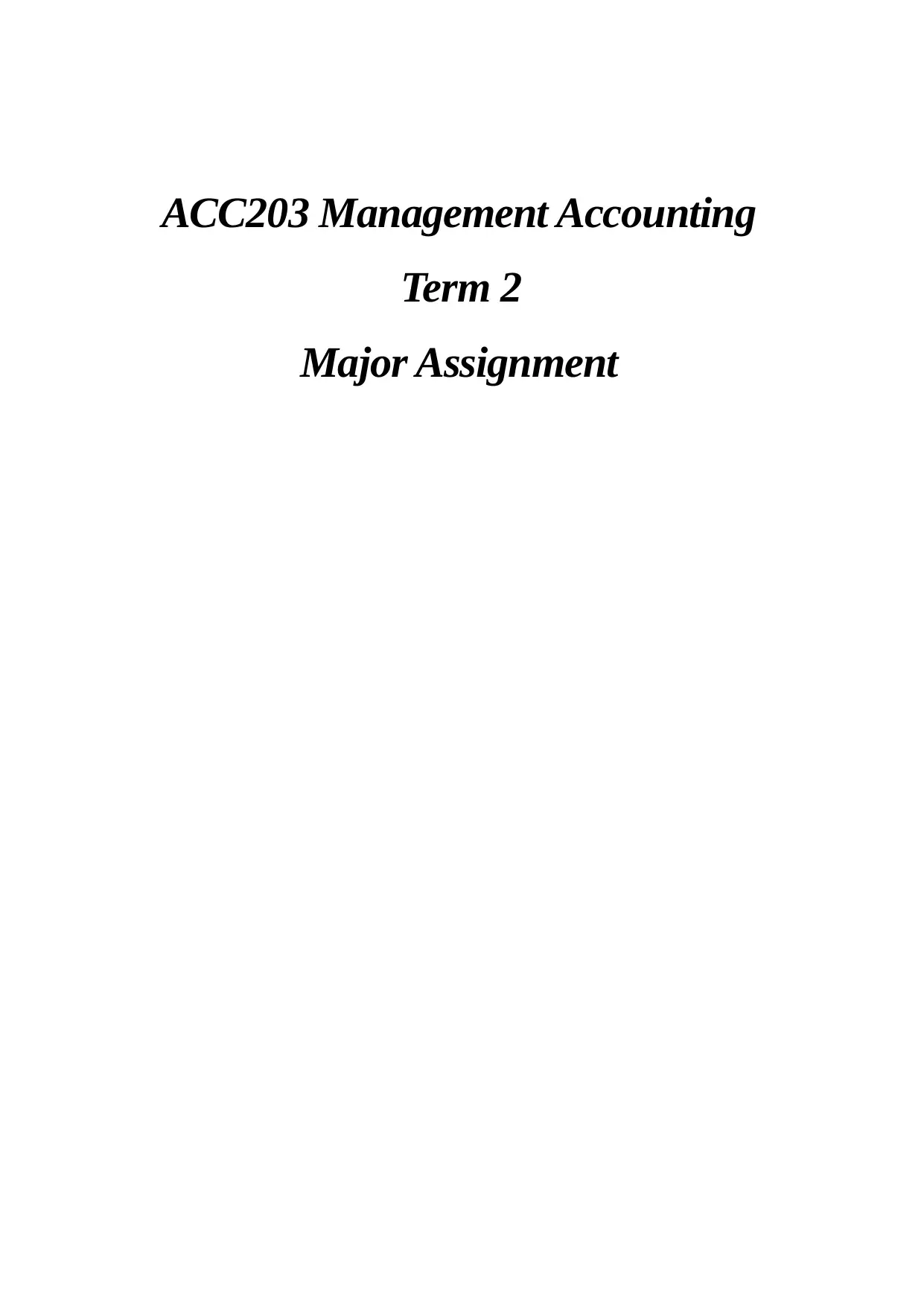
ACC203 Management Accounting
Term 2
Major Assignment
Term 2
Major Assignment
Paraphrase This Document
Need a fresh take? Get an instant paraphrase of this document with our AI Paraphraser
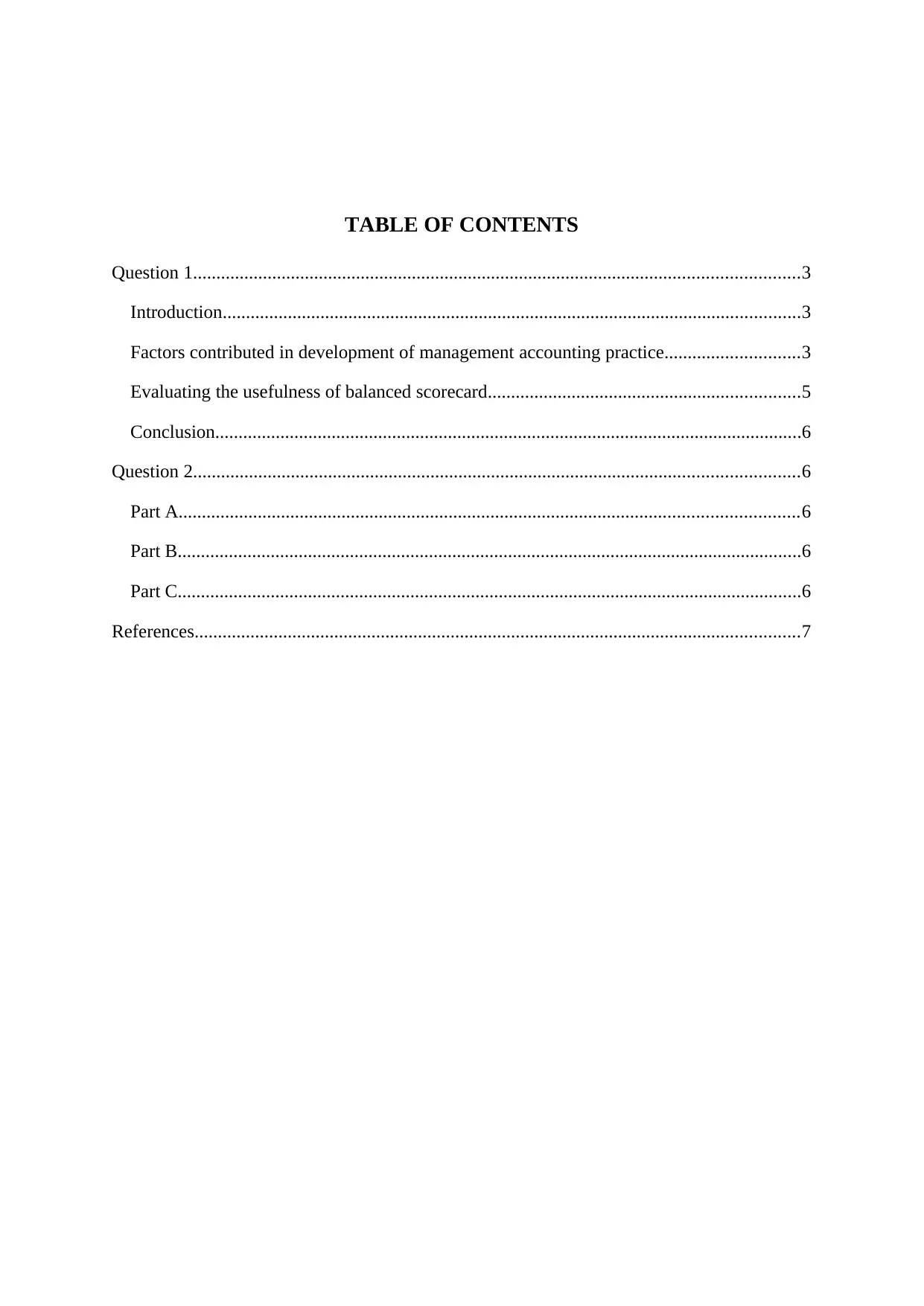
TABLE OF CONTENTS
Question 1..................................................................................................................................3
Introduction............................................................................................................................3
Factors contributed in development of management accounting practice.............................3
Evaluating the usefulness of balanced scorecard...................................................................5
Conclusion..............................................................................................................................6
Question 2..................................................................................................................................6
Part A.....................................................................................................................................6
Part B......................................................................................................................................6
Part C......................................................................................................................................6
References..................................................................................................................................7
Question 1..................................................................................................................................3
Introduction............................................................................................................................3
Factors contributed in development of management accounting practice.............................3
Evaluating the usefulness of balanced scorecard...................................................................5
Conclusion..............................................................................................................................6
Question 2..................................................................................................................................6
Part A.....................................................................................................................................6
Part B......................................................................................................................................6
Part C......................................................................................................................................6
References..................................................................................................................................7

QUESTION 1
Introduction
Modern management accounting practices are playing a significant role in business
decision process within highly volatile market trends. In the current market trends,
management accounting is not only focused on traditional accounting based on compliance
and control but also strategic and competitive factors which assist top managers in collection
of wide range of information such as market demand, market share of competitors, growth
trends, costing of new goods and services and product lifecycle (Mårtensson et al.2016). All
these elements have a great involvement in strategic business accounting as well as a
decision-making process.
Factors contributed to the development of management accounting practice
As a result of a change in business trends, companies in different industries are
applying organizational changes in which management is mainly focusing on innovative
approaches within management accounting practices. In traditional accounting practices,
companies have mainly focused for control and compliance practices through several tools
like cost control, budgeting, cost-benefit analysis and investment appraisal (Nuhu, Baird &
Appuhami, 2016). Apart from that application of a customer-centric approach in the strategic
planning process has influenced management for the adoption of new trends in business
accounting practices that provide significant support to a business entity in highly
competitive market trends. In this context, some important elements of management
accounting practices are discussed below that provide competitive support to top authorities
in a huge competition.
Cost leadership: It is one of the key factors of organizational success within in highly
completive market. According to this approach, companies make an effort in order to produce
its products at the lowest cost with reference to the price of its competitors. This approach
influences companies for application modern accounting practices in business operations
such as business process re-engineering for changing the structure production process,
determination of product lifecycle costing for assessment of cost of products in whole life and
consideration of Zero-base budgeting through which organization can manage its expenditure
as per business priorities (Hald & Thrane, 2016). All these tactics help the firm in offering its
products and services at lower prices as compared to other organization. It also provides
Introduction
Modern management accounting practices are playing a significant role in business
decision process within highly volatile market trends. In the current market trends,
management accounting is not only focused on traditional accounting based on compliance
and control but also strategic and competitive factors which assist top managers in collection
of wide range of information such as market demand, market share of competitors, growth
trends, costing of new goods and services and product lifecycle (Mårtensson et al.2016). All
these elements have a great involvement in strategic business accounting as well as a
decision-making process.
Factors contributed to the development of management accounting practice
As a result of a change in business trends, companies in different industries are
applying organizational changes in which management is mainly focusing on innovative
approaches within management accounting practices. In traditional accounting practices,
companies have mainly focused for control and compliance practices through several tools
like cost control, budgeting, cost-benefit analysis and investment appraisal (Nuhu, Baird &
Appuhami, 2016). Apart from that application of a customer-centric approach in the strategic
planning process has influenced management for the adoption of new trends in business
accounting practices that provide significant support to a business entity in highly
competitive market trends. In this context, some important elements of management
accounting practices are discussed below that provide competitive support to top authorities
in a huge competition.
Cost leadership: It is one of the key factors of organizational success within in highly
completive market. According to this approach, companies make an effort in order to produce
its products at the lowest cost with reference to the price of its competitors. This approach
influences companies for application modern accounting practices in business operations
such as business process re-engineering for changing the structure production process,
determination of product lifecycle costing for assessment of cost of products in whole life and
consideration of Zero-base budgeting through which organization can manage its expenditure
as per business priorities (Hald & Thrane, 2016). All these tactics help the firm in offering its
products and services at lower prices as compared to other organization. It also provides
⊘ This is a preview!⊘
Do you want full access?
Subscribe today to unlock all pages.

Trusted by 1+ million students worldwide
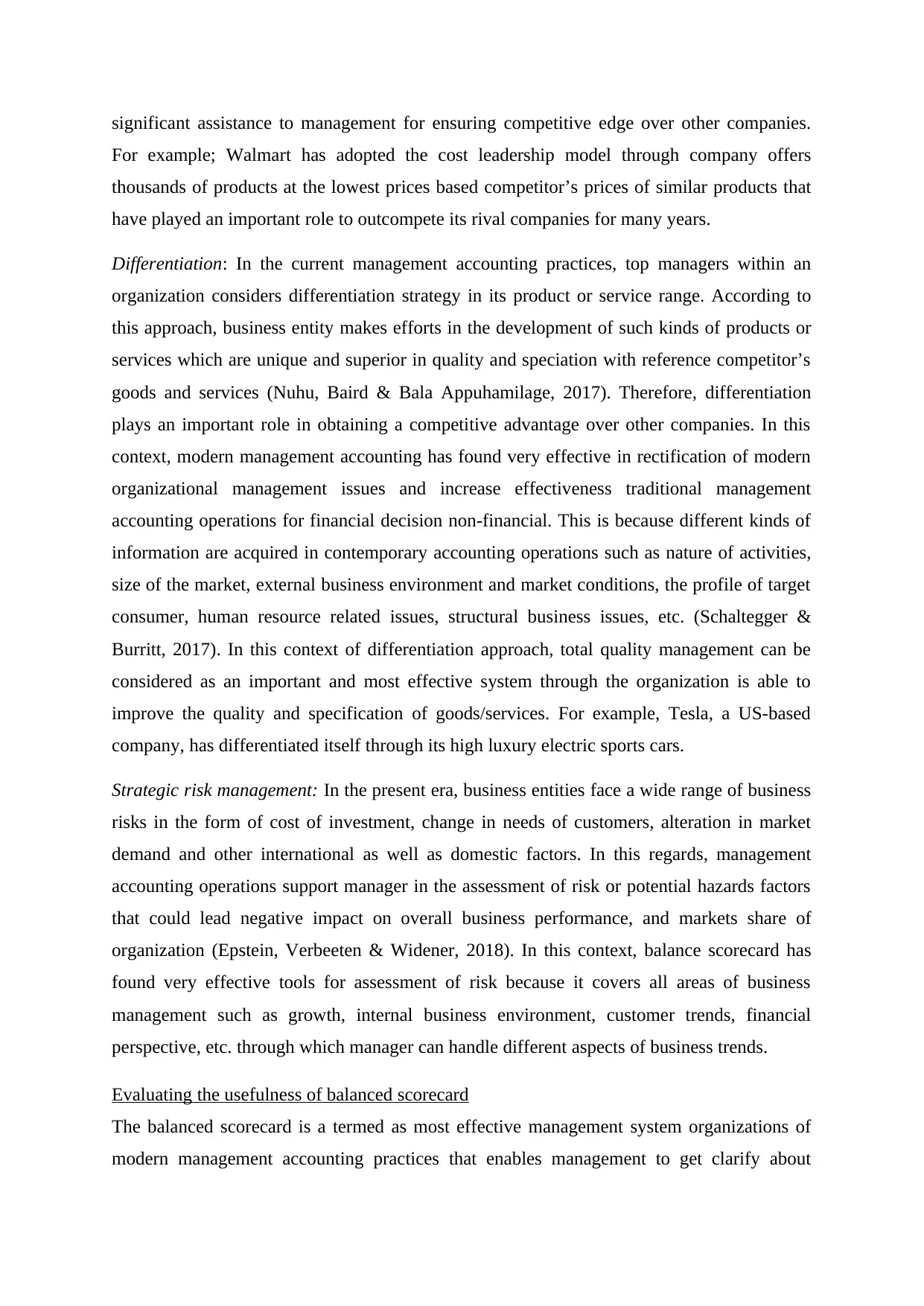
significant assistance to management for ensuring competitive edge over other companies.
For example; Walmart has adopted the cost leadership model through company offers
thousands of products at the lowest prices based competitor’s prices of similar products that
have played an important role to outcompete its rival companies for many years.
Differentiation: In the current management accounting practices, top managers within an
organization considers differentiation strategy in its product or service range. According to
this approach, business entity makes efforts in the development of such kinds of products or
services which are unique and superior in quality and speciation with reference competitor’s
goods and services (Nuhu, Baird & Bala Appuhamilage, 2017). Therefore, differentiation
plays an important role in obtaining a competitive advantage over other companies. In this
context, modern management accounting has found very effective in rectification of modern
organizational management issues and increase effectiveness traditional management
accounting operations for financial decision non-financial. This is because different kinds of
information are acquired in contemporary accounting operations such as nature of activities,
size of the market, external business environment and market conditions, the profile of target
consumer, human resource related issues, structural business issues, etc. (Schaltegger &
Burritt, 2017). In this context of differentiation approach, total quality management can be
considered as an important and most effective system through the organization is able to
improve the quality and specification of goods/services. For example, Tesla, a US-based
company, has differentiated itself through its high luxury electric sports cars.
Strategic risk management: In the present era, business entities face a wide range of business
risks in the form of cost of investment, change in needs of customers, alteration in market
demand and other international as well as domestic factors. In this regards, management
accounting operations support manager in the assessment of risk or potential hazards factors
that could lead negative impact on overall business performance, and markets share of
organization (Epstein, Verbeeten & Widener, 2018). In this context, balance scorecard has
found very effective tools for assessment of risk because it covers all areas of business
management such as growth, internal business environment, customer trends, financial
perspective, etc. through which manager can handle different aspects of business trends.
Evaluating the usefulness of balanced scorecard
The balanced scorecard is a termed as most effective management system organizations of
modern management accounting practices that enables management to get clarify about
For example; Walmart has adopted the cost leadership model through company offers
thousands of products at the lowest prices based competitor’s prices of similar products that
have played an important role to outcompete its rival companies for many years.
Differentiation: In the current management accounting practices, top managers within an
organization considers differentiation strategy in its product or service range. According to
this approach, business entity makes efforts in the development of such kinds of products or
services which are unique and superior in quality and speciation with reference competitor’s
goods and services (Nuhu, Baird & Bala Appuhamilage, 2017). Therefore, differentiation
plays an important role in obtaining a competitive advantage over other companies. In this
context, modern management accounting has found very effective in rectification of modern
organizational management issues and increase effectiveness traditional management
accounting operations for financial decision non-financial. This is because different kinds of
information are acquired in contemporary accounting operations such as nature of activities,
size of the market, external business environment and market conditions, the profile of target
consumer, human resource related issues, structural business issues, etc. (Schaltegger &
Burritt, 2017). In this context of differentiation approach, total quality management can be
considered as an important and most effective system through the organization is able to
improve the quality and specification of goods/services. For example, Tesla, a US-based
company, has differentiated itself through its high luxury electric sports cars.
Strategic risk management: In the present era, business entities face a wide range of business
risks in the form of cost of investment, change in needs of customers, alteration in market
demand and other international as well as domestic factors. In this regards, management
accounting operations support manager in the assessment of risk or potential hazards factors
that could lead negative impact on overall business performance, and markets share of
organization (Epstein, Verbeeten & Widener, 2018). In this context, balance scorecard has
found very effective tools for assessment of risk because it covers all areas of business
management such as growth, internal business environment, customer trends, financial
perspective, etc. through which manager can handle different aspects of business trends.
Evaluating the usefulness of balanced scorecard
The balanced scorecard is a termed as most effective management system organizations of
modern management accounting practices that enables management to get clarify about
Paraphrase This Document
Need a fresh take? Get an instant paraphrase of this document with our AI Paraphraser
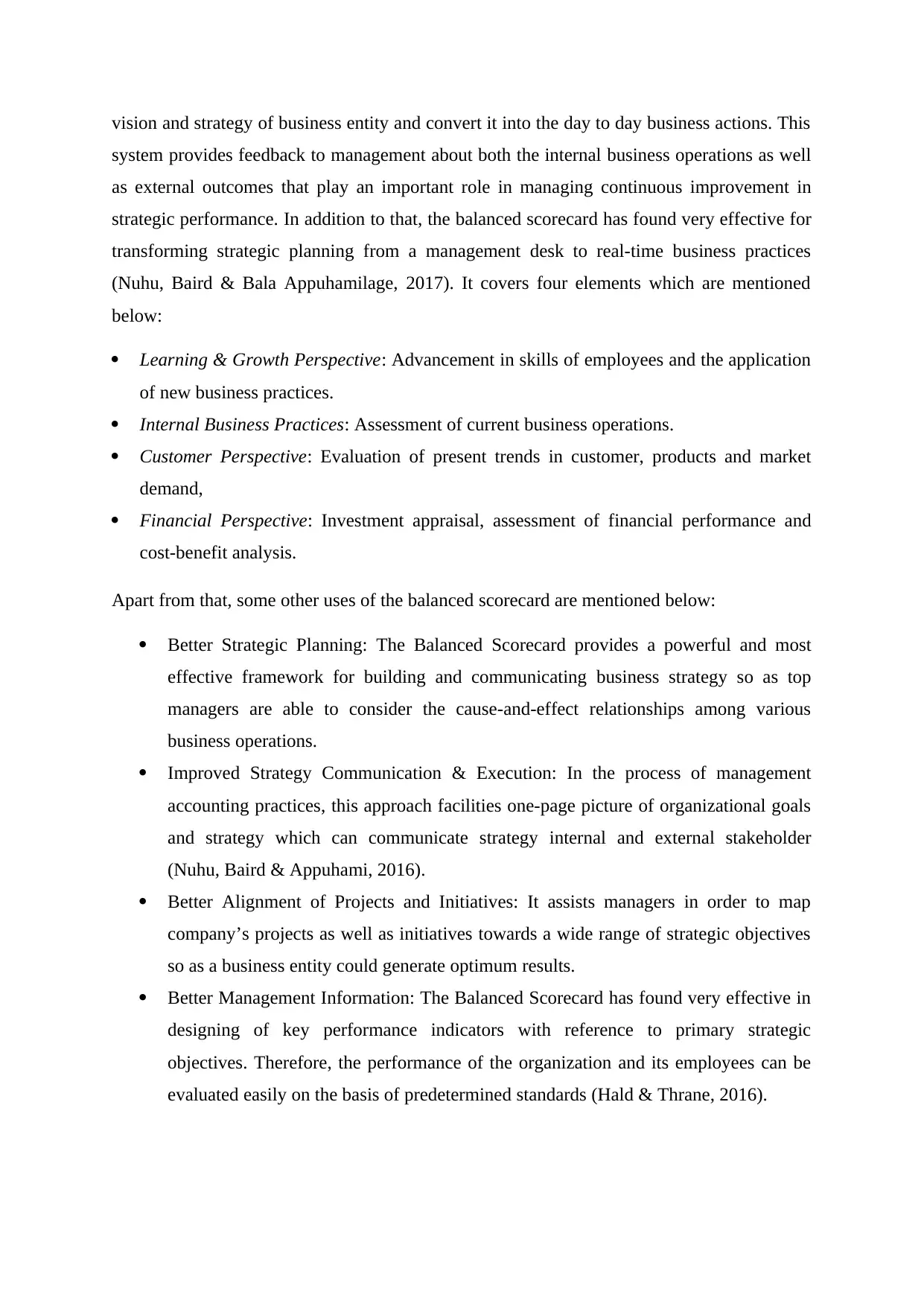
vision and strategy of business entity and convert it into the day to day business actions. This
system provides feedback to management about both the internal business operations as well
as external outcomes that play an important role in managing continuous improvement in
strategic performance. In addition to that, the balanced scorecard has found very effective for
transforming strategic planning from a management desk to real-time business practices
(Nuhu, Baird & Bala Appuhamilage, 2017). It covers four elements which are mentioned
below:
Learning & Growth Perspective: Advancement in skills of employees and the application
of new business practices.
Internal Business Practices: Assessment of current business operations.
Customer Perspective: Evaluation of present trends in customer, products and market
demand,
Financial Perspective: Investment appraisal, assessment of financial performance and
cost-benefit analysis.
Apart from that, some other uses of the balanced scorecard are mentioned below:
Better Strategic Planning: The Balanced Scorecard provides a powerful and most
effective framework for building and communicating business strategy so as top
managers are able to consider the cause-and-effect relationships among various
business operations.
Improved Strategy Communication & Execution: In the process of management
accounting practices, this approach facilities one-page picture of organizational goals
and strategy which can communicate strategy internal and external stakeholder
(Nuhu, Baird & Appuhami, 2016).
Better Alignment of Projects and Initiatives: It assists managers in order to map
company’s projects as well as initiatives towards a wide range of strategic objectives
so as a business entity could generate optimum results.
Better Management Information: The Balanced Scorecard has found very effective in
designing of key performance indicators with reference to primary strategic
objectives. Therefore, the performance of the organization and its employees can be
evaluated easily on the basis of predetermined standards (Hald & Thrane, 2016).
system provides feedback to management about both the internal business operations as well
as external outcomes that play an important role in managing continuous improvement in
strategic performance. In addition to that, the balanced scorecard has found very effective for
transforming strategic planning from a management desk to real-time business practices
(Nuhu, Baird & Bala Appuhamilage, 2017). It covers four elements which are mentioned
below:
Learning & Growth Perspective: Advancement in skills of employees and the application
of new business practices.
Internal Business Practices: Assessment of current business operations.
Customer Perspective: Evaluation of present trends in customer, products and market
demand,
Financial Perspective: Investment appraisal, assessment of financial performance and
cost-benefit analysis.
Apart from that, some other uses of the balanced scorecard are mentioned below:
Better Strategic Planning: The Balanced Scorecard provides a powerful and most
effective framework for building and communicating business strategy so as top
managers are able to consider the cause-and-effect relationships among various
business operations.
Improved Strategy Communication & Execution: In the process of management
accounting practices, this approach facilities one-page picture of organizational goals
and strategy which can communicate strategy internal and external stakeholder
(Nuhu, Baird & Appuhami, 2016).
Better Alignment of Projects and Initiatives: It assists managers in order to map
company’s projects as well as initiatives towards a wide range of strategic objectives
so as a business entity could generate optimum results.
Better Management Information: The Balanced Scorecard has found very effective in
designing of key performance indicators with reference to primary strategic
objectives. Therefore, the performance of the organization and its employees can be
evaluated easily on the basis of predetermined standards (Hald & Thrane, 2016).
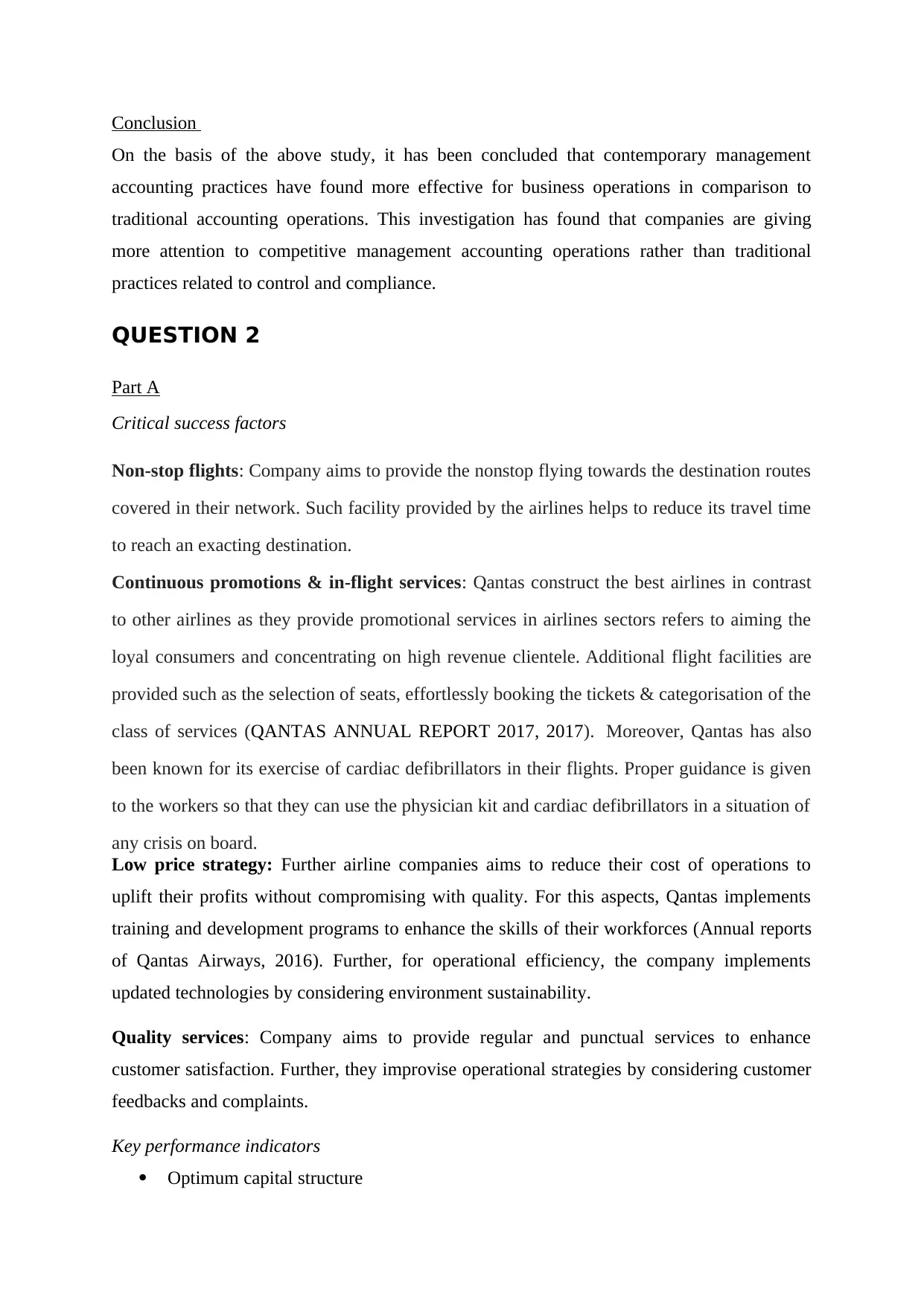
Conclusion
On the basis of the above study, it has been concluded that contemporary management
accounting practices have found more effective for business operations in comparison to
traditional accounting operations. This investigation has found that companies are giving
more attention to competitive management accounting operations rather than traditional
practices related to control and compliance.
QUESTION 2
Part A
Critical success factors
Non-stop flights: Company aims to provide the nonstop flying towards the destination routes
covered in their network. Such facility provided by the airlines helps to reduce its travel time
to reach an exacting destination.
Continuous promotions & in-flight services: Qantas construct the best airlines in contrast
to other airlines as they provide promotional services in airlines sectors refers to aiming the
loyal consumers and concentrating on high revenue clientele. Additional flight facilities are
provided such as the selection of seats, effortlessly booking the tickets & categorisation of the
class of services (QANTAS ANNUAL REPORT 2017, 2017). Moreover, Qantas has also
been known for its exercise of cardiac defibrillators in their flights. Proper guidance is given
to the workers so that they can use the physician kit and cardiac defibrillators in a situation of
any crisis on board.
Low price strategy: Further airline companies aims to reduce their cost of operations to
uplift their profits without compromising with quality. For this aspects, Qantas implements
training and development programs to enhance the skills of their workforces (Annual reports
of Qantas Airways, 2016). Further, for operational efficiency, the company implements
updated technologies by considering environment sustainability.
Quality services: Company aims to provide regular and punctual services to enhance
customer satisfaction. Further, they improvise operational strategies by considering customer
feedbacks and complaints.
Key performance indicators
Optimum capital structure
On the basis of the above study, it has been concluded that contemporary management
accounting practices have found more effective for business operations in comparison to
traditional accounting operations. This investigation has found that companies are giving
more attention to competitive management accounting operations rather than traditional
practices related to control and compliance.
QUESTION 2
Part A
Critical success factors
Non-stop flights: Company aims to provide the nonstop flying towards the destination routes
covered in their network. Such facility provided by the airlines helps to reduce its travel time
to reach an exacting destination.
Continuous promotions & in-flight services: Qantas construct the best airlines in contrast
to other airlines as they provide promotional services in airlines sectors refers to aiming the
loyal consumers and concentrating on high revenue clientele. Additional flight facilities are
provided such as the selection of seats, effortlessly booking the tickets & categorisation of the
class of services (QANTAS ANNUAL REPORT 2017, 2017). Moreover, Qantas has also
been known for its exercise of cardiac defibrillators in their flights. Proper guidance is given
to the workers so that they can use the physician kit and cardiac defibrillators in a situation of
any crisis on board.
Low price strategy: Further airline companies aims to reduce their cost of operations to
uplift their profits without compromising with quality. For this aspects, Qantas implements
training and development programs to enhance the skills of their workforces (Annual reports
of Qantas Airways, 2016). Further, for operational efficiency, the company implements
updated technologies by considering environment sustainability.
Quality services: Company aims to provide regular and punctual services to enhance
customer satisfaction. Further, they improvise operational strategies by considering customer
feedbacks and complaints.
Key performance indicators
Optimum capital structure
⊘ This is a preview!⊘
Do you want full access?
Subscribe today to unlock all pages.

Trusted by 1+ million students worldwide
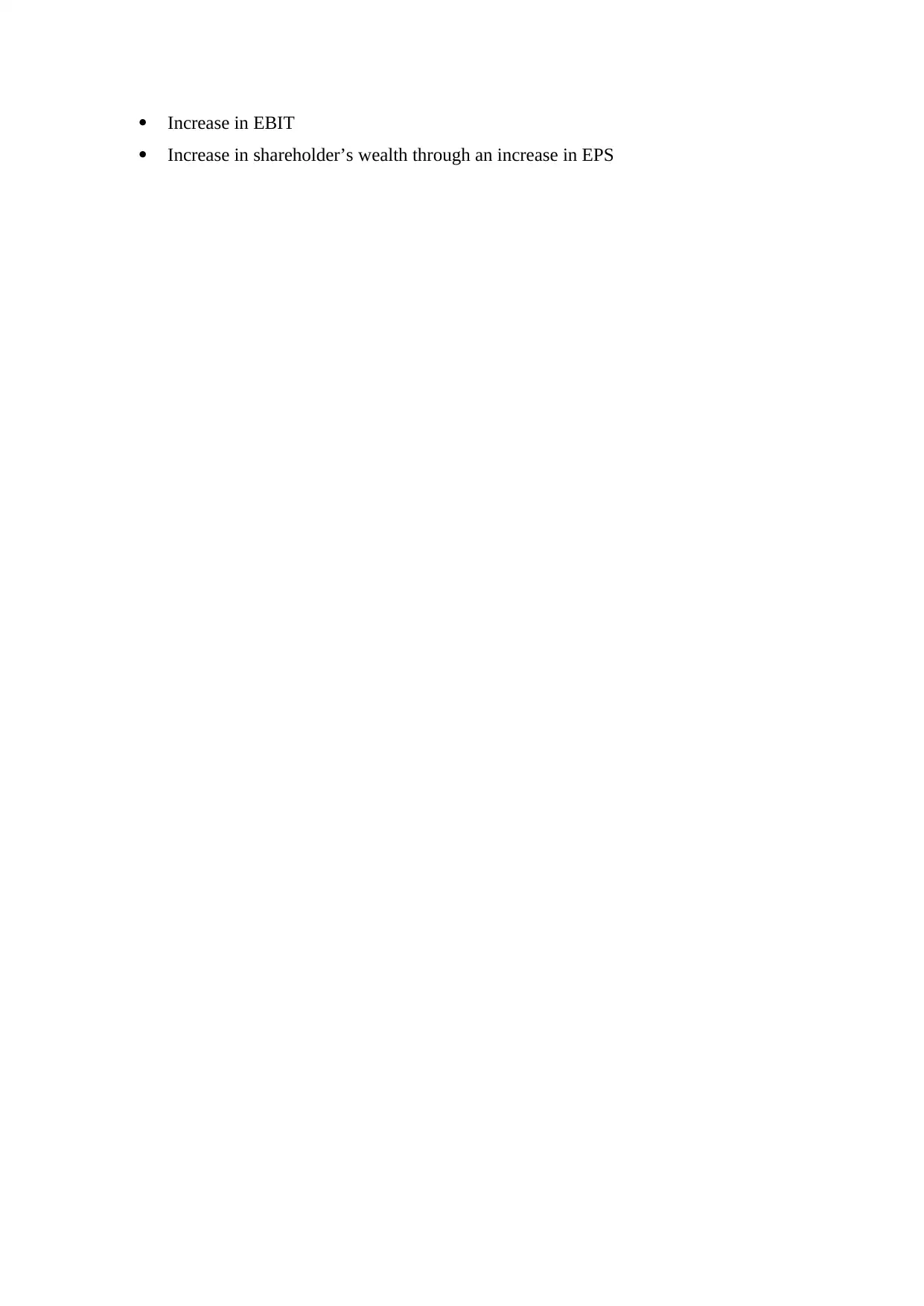
Increase in EBIT
Increase in shareholder’s wealth through an increase in EPS
Increase in shareholder’s wealth through an increase in EPS
Paraphrase This Document
Need a fresh take? Get an instant paraphrase of this document with our AI Paraphraser

Part B
Strategic Map
Financial Optimise capital
structure
Reduced prices Increase in
shareholders wealth
Internal
business
Fleet simplification for operational efficiency
Customer base Loyalty programs The premium on-time performance
Learning Incorporation of new
technologies
Skilled workforce
Strategic Map
Financial Optimise capital
structure
Reduced prices Increase in
shareholders wealth
Internal
business
Fleet simplification for operational efficiency
Customer base Loyalty programs The premium on-time performance
Learning Incorporation of new
technologies
Skilled workforce
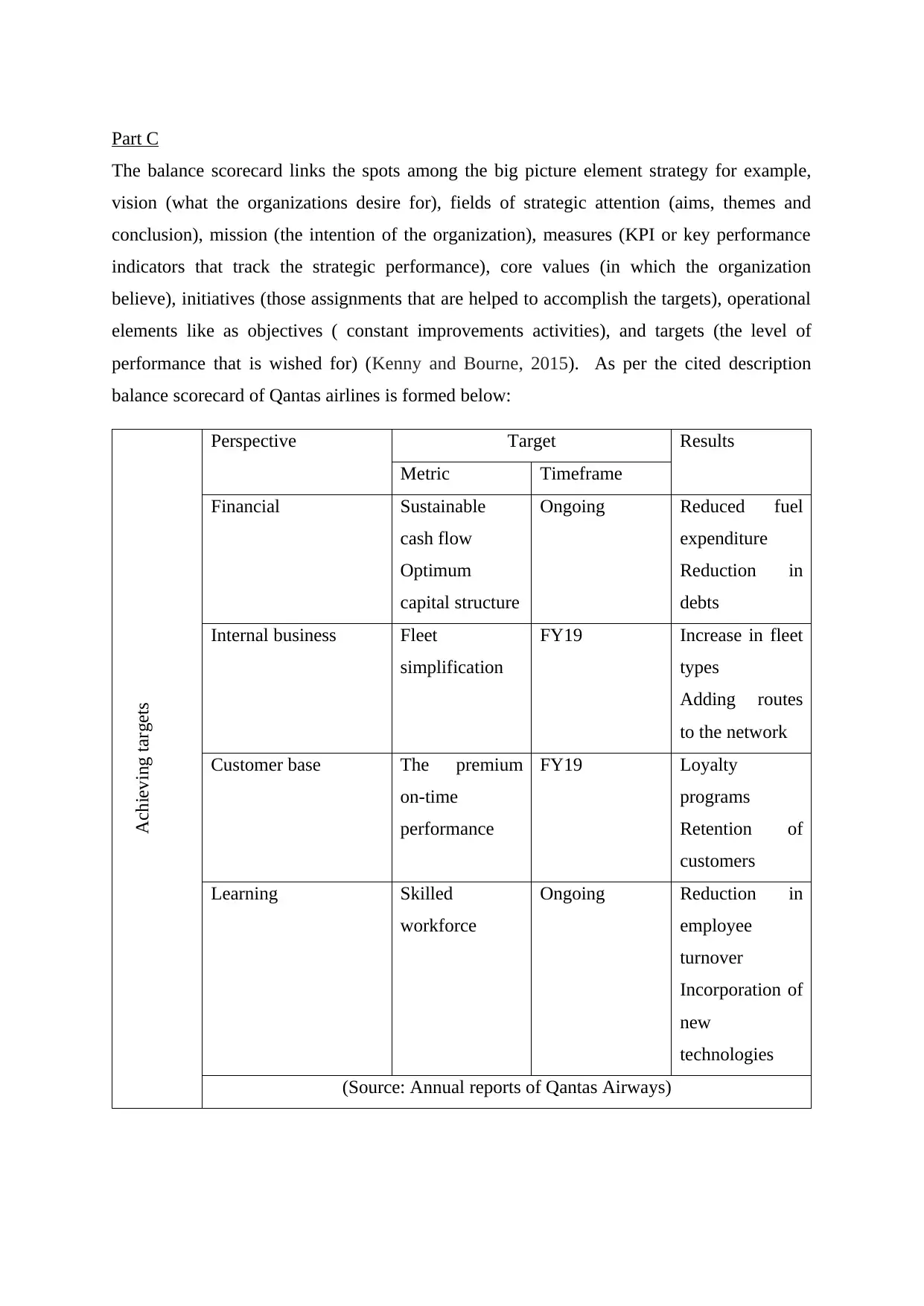
Part C
The balance scorecard links the spots among the big picture element strategy for example,
vision (what the organizations desire for), fields of strategic attention (aims, themes and
conclusion), mission (the intention of the organization), measures (KPI or key performance
indicators that track the strategic performance), core values (in which the organization
believe), initiatives (those assignments that are helped to accomplish the targets), operational
elements like as objectives ( constant improvements activities), and targets (the level of
performance that is wished for) (Kenny and Bourne, 2015). As per the cited description
balance scorecard of Qantas airlines is formed below:
Achieving targets
Perspective Target Results
Metric Timeframe
Financial Sustainable
cash flow
Optimum
capital structure
Ongoing Reduced fuel
expenditure
Reduction in
debts
Internal business Fleet
simplification
FY19 Increase in fleet
types
Adding routes
to the network
Customer base The premium
on-time
performance
FY19 Loyalty
programs
Retention of
customers
Learning Skilled
workforce
Ongoing Reduction in
employee
turnover
Incorporation of
new
technologies
(Source: Annual reports of Qantas Airways)
The balance scorecard links the spots among the big picture element strategy for example,
vision (what the organizations desire for), fields of strategic attention (aims, themes and
conclusion), mission (the intention of the organization), measures (KPI or key performance
indicators that track the strategic performance), core values (in which the organization
believe), initiatives (those assignments that are helped to accomplish the targets), operational
elements like as objectives ( constant improvements activities), and targets (the level of
performance that is wished for) (Kenny and Bourne, 2015). As per the cited description
balance scorecard of Qantas airlines is formed below:
Achieving targets
Perspective Target Results
Metric Timeframe
Financial Sustainable
cash flow
Optimum
capital structure
Ongoing Reduced fuel
expenditure
Reduction in
debts
Internal business Fleet
simplification
FY19 Increase in fleet
types
Adding routes
to the network
Customer base The premium
on-time
performance
FY19 Loyalty
programs
Retention of
customers
Learning Skilled
workforce
Ongoing Reduction in
employee
turnover
Incorporation of
new
technologies
(Source: Annual reports of Qantas Airways)
⊘ This is a preview!⊘
Do you want full access?
Subscribe today to unlock all pages.

Trusted by 1+ million students worldwide
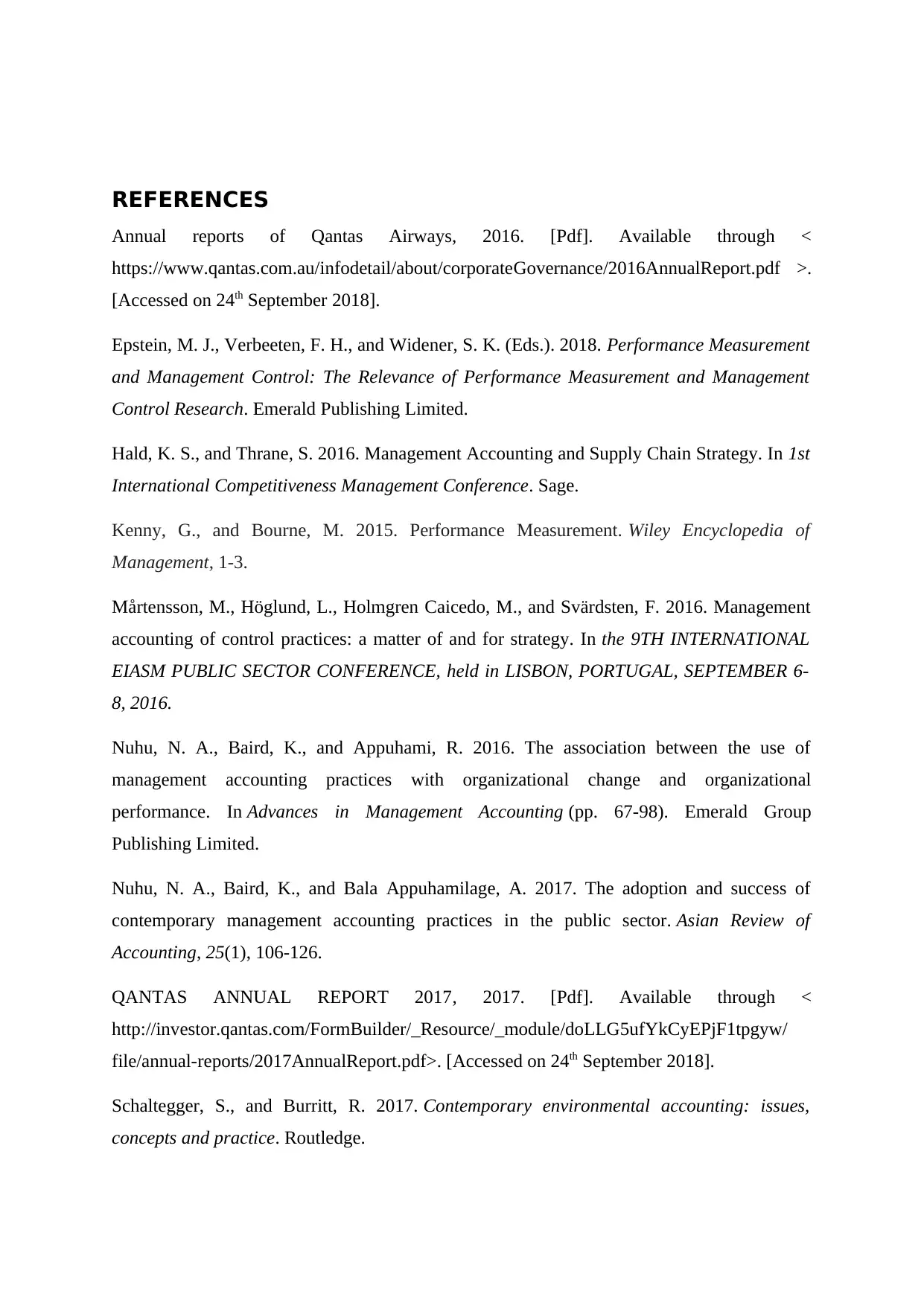
REFERENCES
Annual reports of Qantas Airways, 2016. [Pdf]. Available through <
https://www.qantas.com.au/infodetail/about/corporateGovernance/2016AnnualReport.pdf >.
[Accessed on 24th September 2018].
Epstein, M. J., Verbeeten, F. H., and Widener, S. K. (Eds.). 2018. Performance Measurement
and Management Control: The Relevance of Performance Measurement and Management
Control Research. Emerald Publishing Limited.
Hald, K. S., and Thrane, S. 2016. Management Accounting and Supply Chain Strategy. In 1st
International Competitiveness Management Conference. Sage.
Kenny, G., and Bourne, M. 2015. Performance Measurement. Wiley Encyclopedia of
Management, 1-3.
Mårtensson, M., Höglund, L., Holmgren Caicedo, M., and Svärdsten, F. 2016. Management
accounting of control practices: a matter of and for strategy. In the 9TH INTERNATIONAL
EIASM PUBLIC SECTOR CONFERENCE, held in LISBON, PORTUGAL, SEPTEMBER 6-
8, 2016.
Nuhu, N. A., Baird, K., and Appuhami, R. 2016. The association between the use of
management accounting practices with organizational change and organizational
performance. In Advances in Management Accounting (pp. 67-98). Emerald Group
Publishing Limited.
Nuhu, N. A., Baird, K., and Bala Appuhamilage, A. 2017. The adoption and success of
contemporary management accounting practices in the public sector. Asian Review of
Accounting, 25(1), 106-126.
QANTAS ANNUAL REPORT 2017, 2017. [Pdf]. Available through <
http://investor.qantas.com/FormBuilder/_Resource/_module/doLLG5ufYkCyEPjF1tpgyw/
file/annual-reports/2017AnnualReport.pdf>. [Accessed on 24th September 2018].
Schaltegger, S., and Burritt, R. 2017. Contemporary environmental accounting: issues,
concepts and practice. Routledge.
Annual reports of Qantas Airways, 2016. [Pdf]. Available through <
https://www.qantas.com.au/infodetail/about/corporateGovernance/2016AnnualReport.pdf >.
[Accessed on 24th September 2018].
Epstein, M. J., Verbeeten, F. H., and Widener, S. K. (Eds.). 2018. Performance Measurement
and Management Control: The Relevance of Performance Measurement and Management
Control Research. Emerald Publishing Limited.
Hald, K. S., and Thrane, S. 2016. Management Accounting and Supply Chain Strategy. In 1st
International Competitiveness Management Conference. Sage.
Kenny, G., and Bourne, M. 2015. Performance Measurement. Wiley Encyclopedia of
Management, 1-3.
Mårtensson, M., Höglund, L., Holmgren Caicedo, M., and Svärdsten, F. 2016. Management
accounting of control practices: a matter of and for strategy. In the 9TH INTERNATIONAL
EIASM PUBLIC SECTOR CONFERENCE, held in LISBON, PORTUGAL, SEPTEMBER 6-
8, 2016.
Nuhu, N. A., Baird, K., and Appuhami, R. 2016. The association between the use of
management accounting practices with organizational change and organizational
performance. In Advances in Management Accounting (pp. 67-98). Emerald Group
Publishing Limited.
Nuhu, N. A., Baird, K., and Bala Appuhamilage, A. 2017. The adoption and success of
contemporary management accounting practices in the public sector. Asian Review of
Accounting, 25(1), 106-126.
QANTAS ANNUAL REPORT 2017, 2017. [Pdf]. Available through <
http://investor.qantas.com/FormBuilder/_Resource/_module/doLLG5ufYkCyEPjF1tpgyw/
file/annual-reports/2017AnnualReport.pdf>. [Accessed on 24th September 2018].
Schaltegger, S., and Burritt, R. 2017. Contemporary environmental accounting: issues,
concepts and practice. Routledge.
1 out of 10